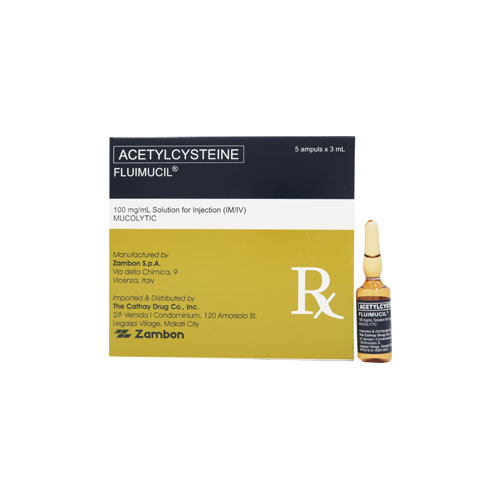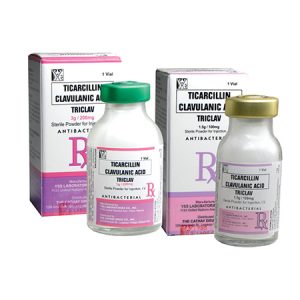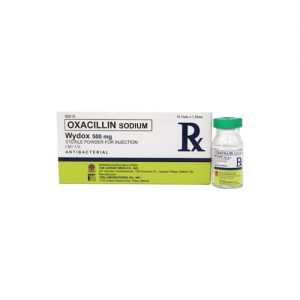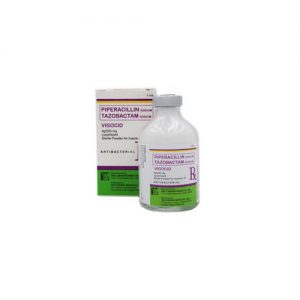Description
The Cathay Drug Co., Inc.
FORMULATION
Each mL of solution contains 100 mg of Acetylcysteine, Ph. Eur.
PRODUCT DESCRIPTION
Acetylcysteine (Fluimucil) is a clear, colourless solution with a slightly sulphureous odour.
PHARMACOLOGICAL PROPERTIES
PHARMACODYNAMIC PROPERTIES
N-acetylcysteine (Acetylcysteine), the active ingredient of FLUIMUCIL, exerts marked mucolytic-fluidifying action on mucous and mucopurulent secretions by depolymerizing the mucoproteic complexes and the nucleic acids that confers viscosity to the vitreous and purulent component of the sputum and other secreta. Additional properties are: reduction of induced hyperplasia of mucous cells increase in surfactant production by stimulation of type II pneumocytes, stimulation of mucociliary activity, leading to improved mucociliary clearance.
Acetylcysteine also exerts a direct antioxidant action, being endowed with a nucleophilic free thiol (-SH) group able to interact directly with the electrophilic group of the oxidizing radicals. Particularly interesting is the recent finding that acetylcysteine protects α1-antitrypsin, an elastase inhibiting enzyme, from the inactivation by hypochlorous acid (HOCl), a powerful oxidizing agent produced by the myeloperoxidase enzyme of activated phagocytes.
Moreover, its molecular structure allows acetylcysteine to easily cross the cellular membranes. Inside the cell, acetylcysteine is deacetylated, thus yielding L-cysteine, an indispensable amino acid for the glutathione synthesis (GSH). Acetylcysteine exerts in addition an indirect antioxidant effect through its role as GSH precursor. GSH is a highly reactive tripeptide, ubiquitously diffused in the various tissues of animal organisms, whichis essential for the maintenance of functional capacity as well as cellular morphological integrity. It represents the most important protective intracellular defense mechanism against oxidizing radicals, both exogenous, endogenous and versus several cytotoxic substances.
PHARMACOKINETIC PROPERTIES
Absorption
Oral Administration
In humans, Acetylcysteine is completely absorbed after oral administration. Because of the gut wall metabolism and first-pass effect, the bioavailability of Acetylcysteine taken orally is very low (approx. 10%). No differences were reported for the various pharmaceutical forms. In patients with various respiratory or cardiac diseases, the maximum plasma concentration is obtained between 1 and 3 hours after administration and the levels remained high over a period of 24 hours.
Distribution
Acetylcysteine is distributed both in the non-metabolized (20%) and the metabolized (active) (80%) form, and can mainly be found in the liver, kidney, lungs and bronchial secretions. The volume of distribution of Acetylcysteine ranges from 0.33 to 0.47 L/kg. Protein binding is about 50% 4 hours after the dose and decreasing to 20% at 12 hours.
There is no information on whether Acetylcysteine crosses the blood-brain barrier or whether it is excreted in breast milk. Acetylcysteine crosses the placenta.
Biotransformation
Acetylcysteine undergoes rapid and extensive metabolism in the gut wall and liver following oral administration.
The resulting compound, cysteine, is considered to be an active metabolite. Following this stage of transformation, Acetylcysteine and cysteine share the same metabolic route.
Renal clearance may account for about 30% of total body clearance. Following oral administration, the terminal half-life of total Acetylcysteine is 6.25 hours.
Elimination
After a single intravenous dose of Acetylcysteine, plasma concentration of total Acetylcysteine shows a poli-exponential decline with a terminal half-life (T1/2) of 5.6 hours. Renal clearance has been defined at 0.11 L/h/kg and it may account for about 30% of total body clearance.
Linearity/non-linearity
The pharmacokinetics of Acetylcysteine is proportional to the administered dose range between 200 – 3200 mg/m2 for AUC and Cmax.
Hepatic insufficiency
In subjects with severe hepatic insufficiency, associated with alcoholic cirrhosis (Child-Pugh score 7-13) or biliary cirrhosis primary or secondary (Child-Pugh score 5-7), elimination half-life (T ½) increased by 80% while the elimination decreased by 30%, as compared to the control group.
Renal insufficiency
There is no pharmacokinetic data available on patients with renal insufficiency.
Pre-clinical Safety Data
Non-clinical data reveal no special hazard for humans based on conventional studies of safety pharmacology, repeated dose toxicity, genotoxicity and toxicity to reproduction and development.
High dose treatment in pregnant rats and rabbits revealed no evidence of impaired female fertility or harm to the fetus due to Acetylcysteine.
Treatment of male rats for 15 weeks with Acetylcysteine at an oral dose considered sufficiently in excess compared to the recommended human dose, did not affect the fertility or general reproductive performance of the animals.
INDICATIONS
Acetylcysteine (FLUIMUCIL) is indicated in the treatment of respiratory conditions characterized by thick and viscous hypersecretions due to acute bronchitis, chronic bronchitis and its exacerbations, pulmonary emphysema, mucoviscidosis and bronchiectasis.
TOPICAL USE
Otorhinolaryngology: catarrhal otitis, tubal catarrh; mucocrustal and mucopurulent rhinitis, sinusitis, rhinopharyngitis, pharyngo-laryngitis, laryngo-tracheitis; prophylaxis and treatment of obstructive and infectious complications of tracheotomy; preparation to bronchoscopy, bronchography, bronchoaspiration, etc.
Medicine-Pediatrics: acute and chronic bronchitis; asthmatic bronchitis, emphysema, chronic bronchopneumonia and pneumonia, pulmonary abscess, bronchiectasis, pulmonary atelectasis, bronchiolitis, mucoviscidosis, certain forms of neonatal asphyxia, etc.
Surgery: prophylaxis and treatment of bronchopulmonary complications following surgical interventions (on thorax, abdomen, etc)
Pulmonary Tuberculosis: bronchial catarrh associated with pulmonary tuberculosis, retention of secretion due to insufficient drainage of cavity lesions.
SYSTEMIC USE
In all cases of above mentioned bronchopulmonary conditions, when topical treatment is difficult or impossible, or when the physician considers the systemic route to be preferable (lack of cooperation on the part of the patient, bedridden patients, respiration in closed circuit, etc.)
DOSAGE AND METHOD OF ADMINISTRATION
Parenteral Administration
Intramuscular Injection
Administration of Acetylcysteine (FLUIMUCIL) ampules is by deep intramuscular injection.
The recommended dosage is 1 ampule 1 to 2 times daily. Dose should be halved in small children.
When administered through the intramuscular route, a slight and transient burning sensation at the site of injection has been reported.
Do not use previously opened ampules for injection.
Intravenous Injection (not as an antidote)
The product must be given by slow infusion in saline solution or 5% glucose solution.
Adults: 1 ampule once or twice daily
Children: half an ampule once or twice daily.
The duration of treatment should be established on the basis of the clinical evaluation. The high general and local tolerability of the product allows for long term treatment.
CONTRAINDICATIONS
Known hypersensitivity to the acetylcysteine or to any of the excipients
Children under 2 years of age.
WARNINGS AND PRECAUTIONS
The administration of Acetylcysteine, mainly at treatment start, might fluidify bronchial secretion and increase their volume. If the patient is not able to effectively expectorate, postural drainage and broncho-aspiration should be performed.
Acetylcysteine should be given by intravenous route under strict medical supervision. The undesirable effects following Acetylcysteine intravenous perfusion are more likely to appear if the drug is administered too quickly or in an excessive amount. It is therefore recommended to strictly follow the indications reported under Dosage and Method of Administration.
Caution is recommended when using the product in patients with peptic ulcer or history of it, especially in case of concomitant administration of other medicines with a known irritating effect on the gastric mucosa.
Bronchial asthma
There is some evidence that patients with a history of atopy and asthma may be at increased risk of developing an anaphylactoid reaction.
Patients suffering from bronchial asthma must be closely monitored during therapy. Should bronchospasm occur, Acetylcysteine must be stopped immediately and appropriate treatment must be initiated.
Histamine intolerance
Acetylcysteine may moderately affect histamine metabolism. Therefore, caution should be used when administering the product for long-term therapy in patients with histamine intolerance since symptoms of intolerance can occur.
Anaphylactoid reactions
Anaphylactoid/hypersensitivity reactions occurs with Acetylcysteine. The patient should be carefully observed during this period for signs of anaphylactoid reaction.
In very rare cases, these reactions have been fatal.
Information on excipients
This medicinal product contains 43 mg sodium (main component of cooking/table salt) in each ampule (1.9 mmol), equivalent 2.15% of the WHO recommended maximum daily intake of 2 g sodium for an adult.
A mild smell of sulphur does not indicate an alteration of the product but pertains to the specific nature of the active ingredient.
Fertility, Pregnancy and lactation
Fertility
No data is available on the effect of Acetylcysteine on human fertility.
Animal studies do not indicate harmful effects with respect to fertility for human at the recommended doses.
Pregnancy
There are limited clinical data from the use of Acetylcysteine in pregnant women.
Animal studies do not indicate harmful effects with respect to reproductive toxicity.
Prior to use in pregnancy, the potential risks should be balanced against the potential benefits.
Breastfeeding
There is no information available on excretion in breast milk.
A risk to the suckling child cannot be excluded.
A decision must be made whether to discontinue breast feeding or to discontinue/abstain from Acetylcysteine (Fluimucil) therapy taking into account the benefit of breast feeding for the child and the benefit of therapy for the woman.
INTERACTIONS
Drug-drug interactions
Antitussive drugs and acetylcysteine should not be concurrently administered because the reduction in cough reflex could lead to accumulation of bronchial secretions.
Concurrent administration of nitroglycerin and acetylcysteine has been shown to cause significant hypotension and enhance temporal artery dilation. If concurrent nitroglycerin and acetylcysteine therapy is necessary, patients should be monitored for hypotension, which can be severe, and warned of the possibility of headaches.
Reports of inactivation of antibiotics resulting from acetylcysteine so far only relate to in vitro tests in which the relevant substances were mixed directly. Therefore, dissolution of acetylcysteine formulations concomitantly with other drugs is not recommended.
Pediatric population
Interaction studies have been performed only in adults
Drug-Lab Modifications
Acetylcysteine may interfere with colorimetric assay method for salicylate measurement.
Acetylcysteine may interfere with urine ketone test.
ADVERSE DRUG REACTIONS
Summary of Safety Profile
Adverse reactions to Acetylcysteine are mainly anaphylactoid, hypersensitivity in nature: urticarial, rash, pruritus are the most frequent features.
Tabulated list of Adverse Drug Reactions
The following adverse reactions were reported during post-marketing experience; their frequency is not known (cannot be estimated from the available data).
TOPICAL USE
| System Organ Class | Adverse Reactions – Frequency Not known (*) |
| Immune System disorders | Hypersensitivity |
| Respiratory, thoracic and mediastinal disorders | Bronchospasm, rhinorrhea |
| Gastrointestinal disorders | Stomatitis, vomiting, nausea |
| Skin and subcutaneous tissue disorders | Urticarial, rash, pruritus |
(*)not known (cannot be estimated from the available data)
Parenteral use
| System Organ Class | Adverse Reactions – Frequency Not known (*) |
| Immune System disorders | Anaphylactic shock, anaphylactic reaction, anaphylactoid reaction, hypersensitivity |
| Cardiac disorders | Tachycardia |
| Respiratory, thoracic and mediatinal disorders | Bronchospasm, dyspnea |
| Gastrointestinal disorders | Vomiting, nausea |
| Skin and subcutaneous tissue disorders | Angioedema, urticaria, flushing, rash, pruritus |
| General disorders and administration site conditions | Face edema |
| Investigations | Blood pressure decreased, prothrombin time prolonged |
(*)not known (cannot be estimated from the available data)
Description of selected adverse reactions
In very rare cases, the occurrence of severe skin reactions such as Stevens-Johnson syndrome and Lyell’s syndrome has been reported in temporal connection with the administration of acetylcysteine.
In most cases, at least one co-suspect drug more probably involved in triggering the reported mucocutaneous syndrome could be identified.
Because of this, medical advice should be sought immediately if any new changes to the skin or mucous membranes occur, and acetylcysteine should be stopped immediately.
A decrease in platelet aggregation in the presence of acetylcysteine has been confirmed by various investigations. The clinical significance has not been established.
Reporting of Suspected Adverse Drug Reaction
Reporting of suspected adverse drug reaction after authorization of the medicinal product is important. It allows continued monitoring of the benefit/risk balance of the medicinal product. Healthcare professionals are asked to report any suspected adverse reaction via the national reporting system.
OVERDOSAGE AND TREATMENT
By intravenous route
Symptoms
Symptoms of Acetylcysteine has been reported to be associated with effects similar to the anaphylactoid reactions noted in Adverse Drug Reactions, but they may be more severe.
Treatment
Treatment of overdose is based on immediate discontinuation of the infusion administration and symptomatic treatment and resuscitation. There are no specific antidotal treatments. Acetylcysteine is dialyzable.
By topical route
No cases of overdose by topical route have been reported. Theoretically, when acetylcysteine is administered in large doses locally, a high degree of liquefaction of mucopurulent secretions may occur, especially in those patients with inadequate coughing reflex or expectoration.
Pediatric population
The same symptoms and treatment apply to the pediatric population
EFFECTS ON THE ABILITY TO DRIVE AND USE MACHINES
Acetylcysteine has no known influence on the ability to drive and use machines.
STORAGE
Store at temperatures not exceeding 30°C.
FORMULATION AND AVAILABILITY
INJECTION (IM/IV)
Acetylcysteine (FLUIMUCIL) Solution for Injection, 300 mg/3 mL ampule, is supplied in box of 5 ampules.
KEEP OUT OF REACH OF CHILDREN.
DO NOT USE BEYOND EXPIRY DATE.
Manufactured by:
Zambon S.p.A.
Via della Chimica, 9-36100
Vicenza (VI), Italy
Marketing Authorization Holder
The Cathay Drug Co., Inc.
2/F Vernida I Condominium
120 Amorsolo St. Legaspi Village
Makati City
Date of revision: July 2019






Reviews
There are no reviews yet.